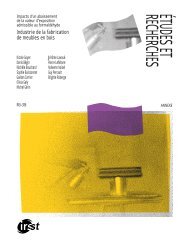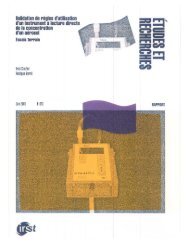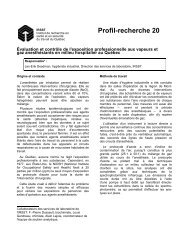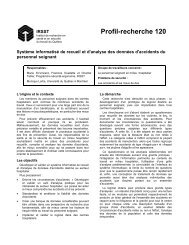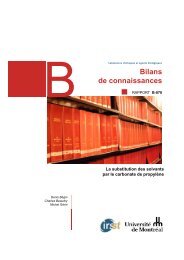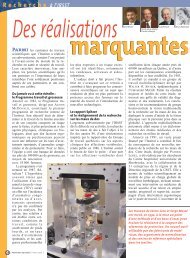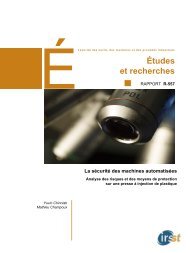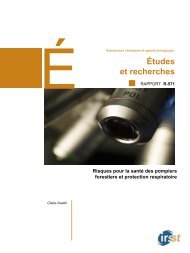Sampling Guide for Air Contaminants in the Workplace - Irsst
Sampling Guide for Air Contaminants in the Workplace - Irsst
Sampling Guide for Air Contaminants in the Workplace - Irsst
You also want an ePaper? Increase the reach of your titles
YUMPU automatically turns print PDFs into web optimized ePapers that Google loves.
38 IRSST – <strong>Sampl<strong>in</strong>g</strong> <strong>Guide</strong> <strong>for</strong> <strong>Air</strong> <strong>Contam<strong>in</strong>ants</strong> <strong>in</strong> <strong>the</strong> <strong>Workplace</strong><br />
Part 3: Contam<strong>in</strong>ant sampl<strong>in</strong>g and analysis<br />
Introduction<br />
The follow<strong>in</strong>g section presents <strong>the</strong> sampl<strong>in</strong>g and analytical parameters used <strong>in</strong> evaluat<strong>in</strong>g occupational<br />
exposure. The PEVs <strong>in</strong> question are listed and def<strong>in</strong>ed <strong>in</strong> <strong>the</strong> ROHS. In<strong>for</strong>mation on <strong>the</strong> pr<strong>in</strong>ciples <strong>for</strong> us<strong>in</strong>g<br />
reference values is presented <strong>in</strong> Part 1 of this document and <strong>in</strong> several publications <strong>in</strong>clud<strong>in</strong>g <strong>the</strong> ACGIH ®<br />
2012 Threshold Limit Values <strong>for</strong> Chemical Substances and Physical Agents and Biological Exposure Indices<br />
(10).<br />
3.1 Specific considerations <strong>for</strong> <strong>the</strong> analytical laboratory<br />
The quality of a result depends on <strong>the</strong> entire evaluation process, <strong>the</strong> establishment of <strong>the</strong> sampl<strong>in</strong>g strategy,<br />
<strong>the</strong> sampl<strong>in</strong>g itself, and <strong>the</strong> laboratory analysis. In this context, it is important to entrust <strong>the</strong> analysis of <strong>the</strong><br />
samples to a recognized laboratory. An occupational hygiene analytical laboratory should be selected on <strong>the</strong><br />
basis of its expertise, its accreditations, and its quality management system. The IRSST's laboratories possess<br />
several accreditations and certifications that ensure, to its partners and clients, <strong>the</strong> quality, <strong>in</strong>tegrity and<br />
recognition of its work.<br />
The IRSST's analytical laboratories are accredited by <strong>the</strong> American Industrial Hygiene Association 6 (AIHA).<br />
To ma<strong>in</strong>ta<strong>in</strong> this accreditation, <strong>the</strong>y comply with <strong>the</strong> <strong>in</strong>ternational standard ISO/IEC 17025:1999 and with <strong>the</strong><br />
AIHA's requirements to provide proof of <strong>the</strong> management of a quality system, <strong>the</strong> existence of appropriate<br />
technical competence with<strong>in</strong> <strong>the</strong> IRSST, and <strong>the</strong> technical validity of <strong>the</strong> results produced. This quality system<br />
is supported by a series of documents such as procedures and work <strong>in</strong>structions that reflect <strong>the</strong> activities<br />
carried out <strong>in</strong> <strong>the</strong> laboratories. The application of <strong>the</strong> requirements of quality documentation implies that<br />
quality records and techniques are reta<strong>in</strong>ed to allow <strong>the</strong> traceability 7 of <strong>the</strong> measurements and analyses. The<br />
provisions of <strong>the</strong> quality system are established <strong>in</strong> a Quality Manual and apply to <strong>the</strong> analyses associated with<br />
<strong>the</strong> different scopes of accreditation.<br />
3.2 Table of substances <strong>in</strong> <strong>the</strong> ROHS and <strong>the</strong> substances analyzed by <strong>the</strong> IRSST<br />
This part of <strong>the</strong> guide conta<strong>in</strong>s two tables. The first table (green pages) conta<strong>in</strong>s all of <strong>the</strong> substances <strong>in</strong> <strong>the</strong><br />
ROHS (namely 706) as well as <strong>in</strong><strong>for</strong>mation on IRSST methods or on o<strong>the</strong>r methods that are recommended by<br />
<strong>the</strong> IRSST. The latter methods were chosen by a review committee consist<strong>in</strong>g of four chemists based on <strong>the</strong><br />
literature available <strong>in</strong> 1994. For each of <strong>the</strong> substances, a file exists <strong>in</strong> <strong>the</strong> Laboratory Division that conta<strong>in</strong>s a<br />
copy of <strong>the</strong> chosen method as well as some o<strong>the</strong>r methods that were not selected. It is important to mention<br />
that no laboratory test was per<strong>for</strong>med regard<strong>in</strong>g <strong>the</strong> recommended methods. In this context, <strong>the</strong><br />
implementation of <strong>the</strong>se methods must undergo an appropriate analytical validation process. The majority of<br />
<strong>the</strong> recommended methods come from <strong>the</strong> two follow<strong>in</strong>g organizations: NIOSH (National Institute <strong>for</strong><br />
Occupational Safety and Health) and OSHA (Occupational Safety and Health Adm<strong>in</strong>istration). This is <strong>the</strong> list<br />
of documents or Web sites that were consulted.<br />
• NIOSH Manual of Analytical Methods, second edition, Volumes 1 to 7, published from 1977 to 1980,<br />
C<strong>in</strong>c<strong>in</strong>nati, OH.<br />
• NIOSH Manual of Analytical Methods, third edition, published from 1984 to 1994, C<strong>in</strong>c<strong>in</strong>nati, OH.<br />
http://www.cdc.gov/niosh/nmam/<br />
• OSHA Analytical Methods Manual (Organic and Inorganic), published from 1985 to 1991, Salt Lake<br />
City, UT http://www.osha.gov/dts/sltc/methods/<br />
• OSHA Chemical In<strong>for</strong>mation File, published <strong>in</strong> 1991, Salt Lake City, UT.<br />
6<br />
7<br />
http://apps.aiha.org/qms_aiha/certificate/101913_certificate.pdf<br />
Traceability means follow<strong>in</strong>g <strong>the</strong> trail taken by <strong>the</strong> sample, from its reception until <strong>the</strong> analytical report is<br />
produced.



